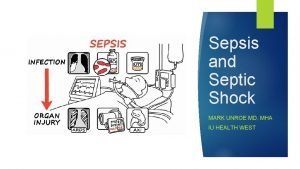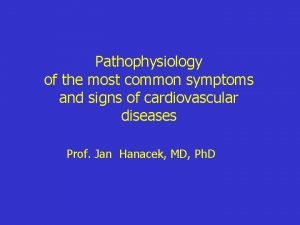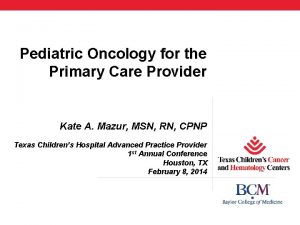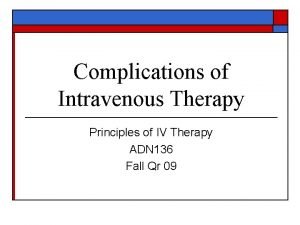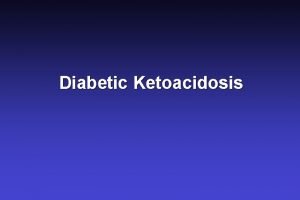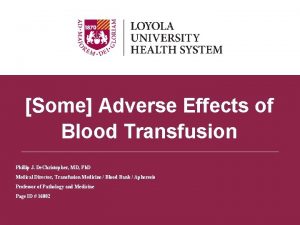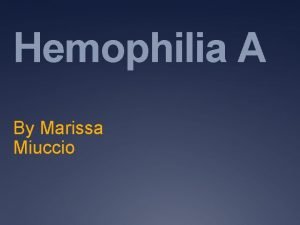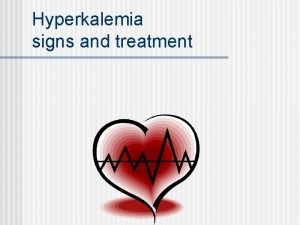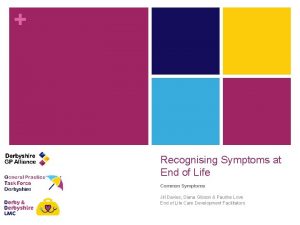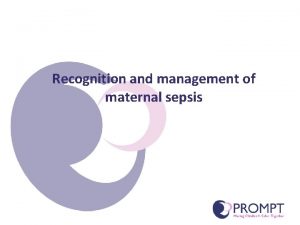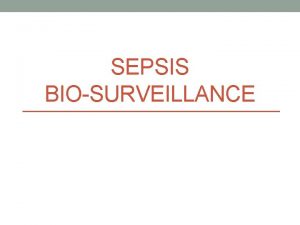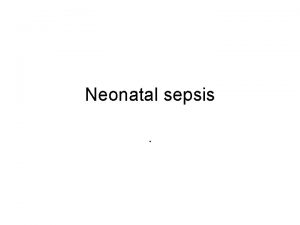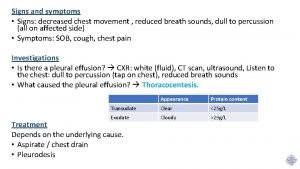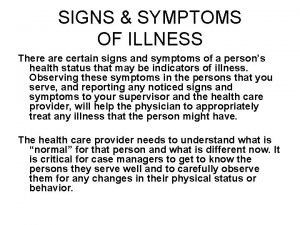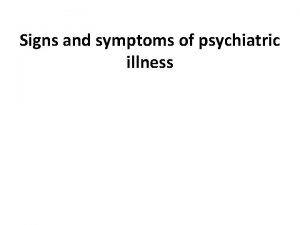Understanding Sepsis Recognising Signs Symptoms in the Frail



















- Slides: 19

Understanding Sepsis Recognising Signs & Symptoms in the Frail & Elderly

Learning Objectives • Recognise signs and symptoms of sepsis in the elderly • Have an understanding of preventive strategies • Identify effective treatment • Recall the complexities of managing sepsis at the end of life • Describe a holistic approach to sepsis in the elderly

Introduction • The incidence of sepsis is increasing, and as a cause of hospital admission has more than doubled over the last ten years. This trend is likely to continue as people are living longer and experiencing more intensive interventions. • For some people, such as older people with advanced frailty or dementia, sepsis is a common and largely irreversible cause of death.

What is Sepsis? • Sepsis is a common and potentially lifethreatening condition triggered by an infection. • Infection is common and occurs when microbes invade the body producing disease. • Sepsis - Sepsis occurs when infection produces a dysfunctional host response resulting in lifethreatening organ dysfunction e. g. acute kidney injury arising from pneumonia.

Signs & Symptoms of Sepsis v Fever, increased heart rate, increased breathing rate, and confusion. v Cough with pneumonia, or painful urination with a kidney infection. v In the very young, old, and people with a weakened immune system, there may be no symptoms of a specific infection and the body temperature may be low or normal rather than high v Evidence of severe symptoms may include low BP, high blood lactate or low urinary output

What is Septic Shock? Septic Shock - Septic shock occurs when this response results in impaired blood supply to organs requiring specific treatments to maintain adequate perfusion. Initially this will usually be detectable by a low blood

Risk of Sepsis in the Elderly • Elderly patients are assessed for sepsis in the same way as all adults. • Risk can be classified as moderate or high risk when assessing a patient with possible sepsis. Low risk is deemed to be when no moderate or high criteria are met. • These physiological parameters should be viewed in the context of the patient’s normal values if known, and any relevant medication such as beta blockers, any pre-existent illness such as COPD, or any pre-existent cognitive problems.

Moderate Risk Respiratory rate: breaths 21 -24 per minute High risk Respiratory rate greater or equal to 25 Pulse: beats per minute 91 -130 or new onset arrhythmia >130 Blood pressure: systolic 91 -100 mm. Hg <90 mm. Hg or >40 mgs Hg drop New requirement for oxygen supplementation to keep saturations > 92% or 88% if have COPD. Only measure in community if does not cause delay in assessment or treatment Oxygen saturations Urine output Temperature Level of alertness Not passed urine > 12 hours Not passed urine > 18 hours Tympanic temperature Can be high or low so do less than 37. 6 o. C not use to rule in or out History from patient friend Objective evidence of new or relative of new onset of altered mental state is altered behaviour or high risk mental state

Outcomes Depends on severity. Risk of death: Sepsis – 30% Severe sepsis – 50% Septic shock – 80% Sepsis is more common among males than females.

Is Sepsis Preventable? Some cases of sepsis are likely to be preventable. This is particularly true in groups of people who are at the greatest risk, including those at the extremities of life – the very young and the very old. The most effective ways to help prevent infections that can lead to sepsis include: v Good hand hygiene v Urinary tract infection (UTI) prevention v Vaccinations v Antimicrobial Stewardship

Hand Hygiene When? • After removing PPE • After touching any bodily fluid (other than tears or sweat) • If hands are visibly dirty or soiled • Before and after handling food • After handling waste • Before and after visiting or caring for sick people

Urinary Tract Infections v 5 -10% of elderly residents of long-term care facilities require chronic indwelling catheters for management of urine voiding. v After catheterisation patients’ bladders very quickly become colonised because of biofilm formation along the catheter.

Vaccinations Influenza Immunocompromised vaccinations Pneumonia Shingles

Influenza v Annual influenza vaccination is recommended for all patients over the age of 65. Influenza severely affects the vulnerable, especially the elderly. v Mortality is commonly through secondary bacterial infection rather than through the primary illness. v Vaccination protects individuals and disrupts spread. Annual influenza vaccinations, and additional pneumonia vaccination are recommended for patients with compromised immune systems

Shingles vaccine is given as a single injection annually to people reaching their 70 th birthday with a catch-up campaign for 78/79 year olds. v Shingles vaccine occasionally prevents sepsis, but its role is generally for prevention of local complications and viraemia. v Patients who are immunosuppressed might benefit from immunoglobulins for passive immunity after exposure to infections or for prophylaxis.

Pneumonia vaccine is offered as a single injection at the age of 65 (or later as a ‘catch-up). It is efficient for clinicians to run the flu vaccination and pneumonia vaccination campaigns in tandem, and it saves patients extra visits. v Pneumonia vaccine is effective against 96% of the isolates causing sepsis but it does not protect against non-bacteraemic disease such as exacerbations of chronic bronchitis.

Antimicrobial Stewardship “The danger posed by growing resistance to antibiotics should be ranked along with terrorism on a list of threats to the nation. If we don't take action, then we may all be back in an almost 19 th Century environment where infections kill us as a result of routine operations. We won't be able to do a lot of our cancer treatments or organ transplants”

Treatment v Sepsis Six care bundle! 1. 2. 3. 4. 5. Administer high flow oxygen. Take blood cultures. Give broad spectrum antibiotics. Give intravenous fluid challenges. Measure serum lactate and haemoglobin. 6. Measure accurate hourly urine output.

Sepsis or not? Don’t forget that Cesl. S M ANY bacterial Sleuieepn. R n. M plpsigstis. Sisits. A s is infection can lead to Sepsis!
 Q sofa
Q sofa Divided highway begins sign
Divided highway begins sign Hod vasundhara
Hod vasundhara Recognising opportunities
Recognising opportunities He's thin tall pale and frail
He's thin tall pale and frail Calbala
Calbala Frag words that mean break
Frag words that mean break Cut grass larkin
Cut grass larkin Do you still get period cramps when pregnant
Do you still get period cramps when pregnant Paroxysmal nocturnal dyspnea pathophysiology
Paroxysmal nocturnal dyspnea pathophysiology Hyperkalemia signs and symptoms
Hyperkalemia signs and symptoms Kate
Kate Hypocalcemia signs and symptoms
Hypocalcemia signs and symptoms Pes statement
Pes statement Infiltrated iv pictures
Infiltrated iv pictures Diabetic ketoacidosis anion gap
Diabetic ketoacidosis anion gap Taco vs trali
Taco vs trali Hemophilia a
Hemophilia a Signs and symptoms of trali
Signs and symptoms of trali Signs hyperkalemia
Signs hyperkalemia
